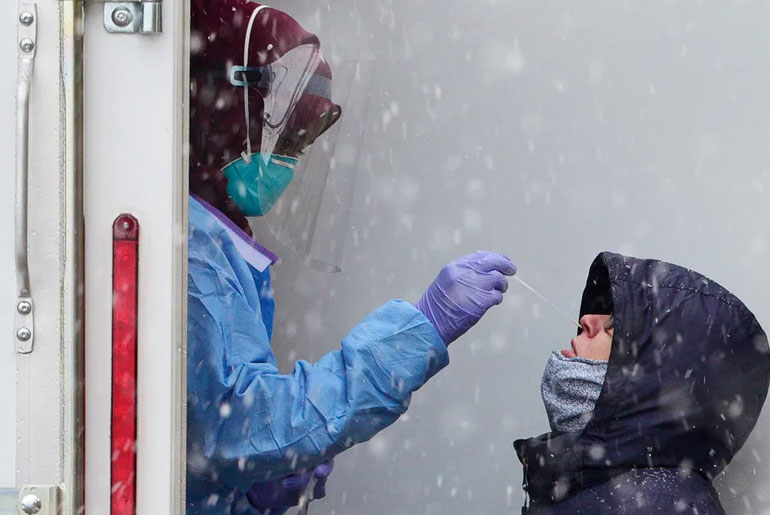Germany is experiencing a resurgence of COVID-19, as indicated by wastewater tests showing higher prevalence than any time since June 2022. Despite the diminished severity of the virus due to widespread vaccinations and baseline immunity in the population, general practitioners like Lars Rettstadt remain occupied. According to Rettstadt, approximately 80% of patients seeking medical attention have viral infections, with half of these cases attributed to the coronavirus. This suggests that, while COVID-19 may have lost some of its fearsome reputation, it continues to be a significant factor in the current health landscape, requiring medical attention and contributing to the workload of healthcare professionals.
“It’s typical infection season again. There’s a lot of sniffling and coughing,” the doctor in Dortmund, a city in western Germany, stated. “When we open the door on Monday morning, there are 70 people without an appointment: men, women, young and old.”
Only few severe cases:
In the absence of a mask mandate, a medical practice led by Rettstadt has implemented its own measures to address the COVID-19 situation. Patients are not required to wear masks, but the practice offers them for a minimal fee of 50 cents. Rettstadt has dedicated specific hours for infection appointments and provides the option of virtual consultations via video. PCR tests are selectively administered to individuals with severe symptoms. Notably, the medical practice reports a scarcity of severe COVID-19 cases, with only one patient, aged 94, requiring hospitalization. Instead, most cases present with symptoms resembling common winter illnesses, leading to individuals taking sick leave for up to two weeks to recover at home. Despite the absence of a mask mandate, the practice’s measures seem to contribute to a lower prevalence of severe cases and a focus on managing milder symptoms.
Respiratory infections:
The ongoing surge in respiratory infections, as reported by Germany’s Robert Koch Institute for public health, is causing significant disruptions, even if the illnesses themselves are not necessarily fatal. With up to 10% of the country’s population falling sick, offices and services are facing challenges in maintaining regular operations. As the holiday season approaches, Health Minister Karl Lauterbach is urging the public to prioritize getting their vaccinations updated. The aim is to mitigate the impact of the infections, especially with the anticipated increase in social interactions during the mix-and-mingle Christmas season. This highlights the importance of vaccination as a preventive measure to reduce illness and maintain societal functioning amidst the ongoing health challenges.
The officially reported 7-day incidence of 38 in Germany may appear relatively low compared to the peak of the Omicron wave in early 2022, which reached 2,000. However, the reliability of this number is questioned due to sporadic testing, potentially providing a deceivingly low figure. Wastewater testing, initiated in June 2022, has revealed an increased presence of coronavirus, suggesting a potentially higher actual incidence. According to virologist Martin Stürmer based in Frankfurt, other forms of PCR testing indicate a 7-day incidence of almost 3,900 in the western German state of Rhineland-Palatinate, a significant rise from the previous week’s 2,600. Stürmer emphasizes that the country is entering a phase of substantial and rapid increase in coronavirus figures, emphasizing the need for vigilance and continued monitoring of the situation.
Pirola variants on the rise:
The rise in coronavirus figures is accompanied by an increase in flu and RSV cases, but surprisingly, this hasn’t translated into a higher burden on hospitals and ICU wards, according to virologist Martin Stürmer. Deaths remain stable. Among the many variants, the “JN.1 variant, another successor variant of Pirola, is now responsible for almost a third of cases.” While the risk to the general population is considered low, Stürmer emphasizes the importance of boosters for at-risk groups, particularly individuals over 60, to provide an additional layer of defense against potential complications such as Long Covid. Stürmer suggests that masks could still be sensible, though public willingness to return to them appears limited.
“The willingness to be vaccinated is also certainly at a low level,” Stürmer stated. “I think these are all factors that we could significantly improve with positive and meaningful communication.”
Disclaimer:
The information contained in this article is for educational and informational purposes only and is not intended as a health advice. We would ask you to consult a qualified professional or medical expert to gain additional knowledge before you choose to consume any product or perform any exercise.







